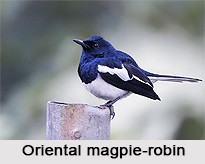 Oriental Magpie-Robin is an Indian Bird that bears a scientific name "Copsychus saularis" has the distinctive looks and widespread in South East Asia and the Indian states like West Bengal, Bihar, Odisha, Karnataka, Madhya Pradesh, Andhra Pradesh, Uttar Pradesh, Rajasthan, Goa, Maharashtra.
Oriental Magpie-Robin is an Indian Bird that bears a scientific name "Copsychus saularis" has the distinctive looks and widespread in South East Asia and the Indian states like West Bengal, Bihar, Odisha, Karnataka, Madhya Pradesh, Andhra Pradesh, Uttar Pradesh, Rajasthan, Goa, Maharashtra.
Category of Oriental Magpie-Robin
Oriental Magpie-Robin is a small passerine bird that was formerly classed as a member of the thrush family of Turdidae, but now considered an Old World flycatcher.
Structure of Oriental Magpie-Robin
Oriental Magpie-Robins are distinctive black and white birds with a long tail that is held upright as they forage on the ground or perch conspicuously. Occurring across most of the Indian subcontinent and parts of Southeast Asia, they are common birds in urban gardens as well as forests. They are particularly well known for their songs and were once popular as cage birds. The oriental magpie-robin is considered the national bird of Bangladesh.
Size of Oriental Magpie-Robin
Oriental Magpie-Robin is 19 centimetres (7.5 in) long, including the long tail that is usually held cocked upright. It is similar in shape to the smaller European robin, but is longer-tailed. The male has black upperparts, head and throat apart from a white shoulder patch. The under parts and the sides of the long tail are white. Females are greyish black above and greyish white. Young birds have scaly brown upperparts and head.
Races of Oriental Magpie-Robin
The nominate race of Oriental Magpie-Robin is found on the Indian states and the females of this race are the palest. The females of the Andamans race andamanensis are darker, heavier-billed and shorter-tailed. The Sri Lankan race ceylonensis (formerly included in the Peninsular Indian populations south of the Kaveri River) and southern nominate individuals have the females nearly identical to the males in shade. The eastern populations (Bhutan and Bangladesh) have more black on the tail and were formerly named erimelas. The populations in Burma and further south are named as race musicus. A number of other races have been named across the range including prosthopellus (Hong Kong), nesiotes, zacnecus, nesiarchus, masculus, pagiensis, javensis, problematicus, amoenus, adamsi, pluto, deuteronymus and mindanensis. However many of these are not well marked and the status of some are disputed. Some like mindanensis have been now been recognized usually as full species. There is more geographic variation in the plumage of females than in that of the males.
Habitat of Oriental Magpie-Robin
Oriental Magpie-Robin is mostly seen close to the ground, hopping along branches or foraging in leaf-litter on the ground with cocked tail. The males of Oriental Magpie-Robin sing loudly from the top of trees or other high perches during the breeding season.
Breeding of Oriental Magpie-Robin
Oriental Magpie-Robin breeds mainly from March to July in India and from January to June in south-east Asia. Males sing from high perches during courtship. The display of the male involves puffing up the feathers, raising the bill, fanning the tail and strutting.
Nests of Oriental Magpie-Robin
Oriental Magpie-Robin nest in tree hollows or niches in walls or building, often adopting nest boxes. They line the cavity with grass. The female is involved in most of the nest building that happens about a week before the eggs are laid. Four or five eggs are laid in intervals of 24 hours and these are oval and usually pale blue green with brownish speckles which match the colours of hay. The eggs are incubated by the female alone for 8 to 14 days. The nests are said to have a characteristic odour.











